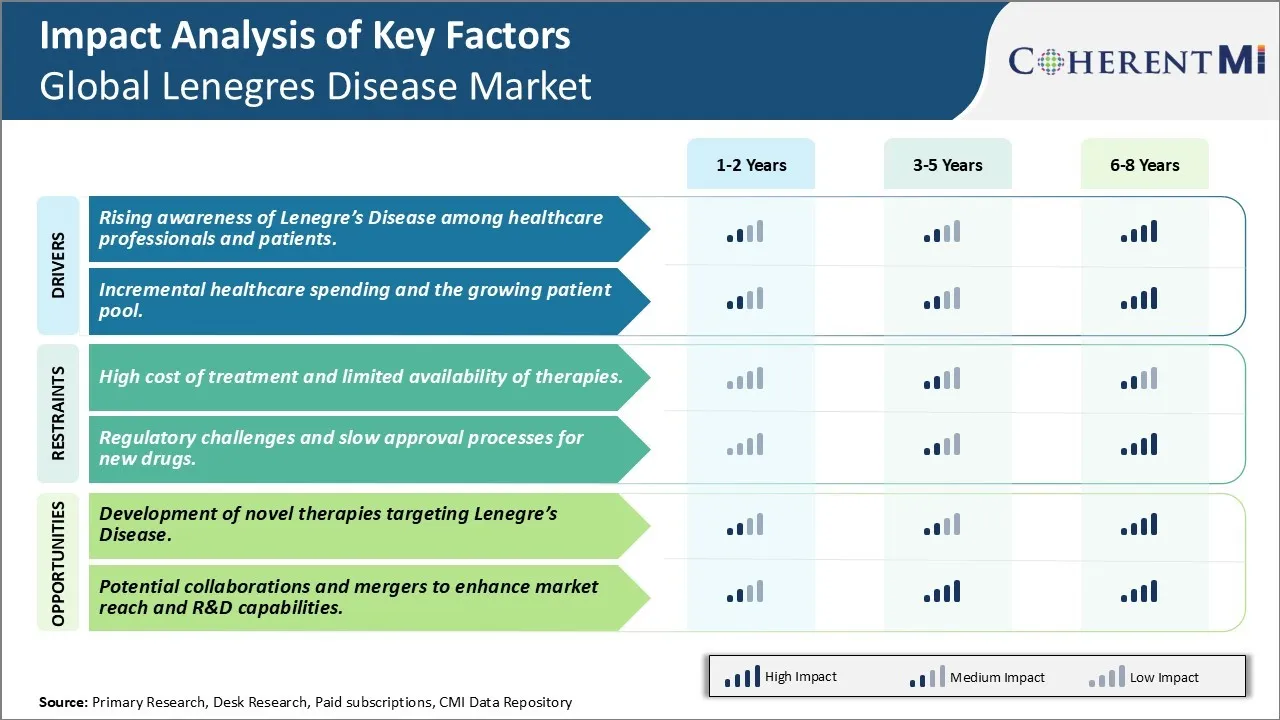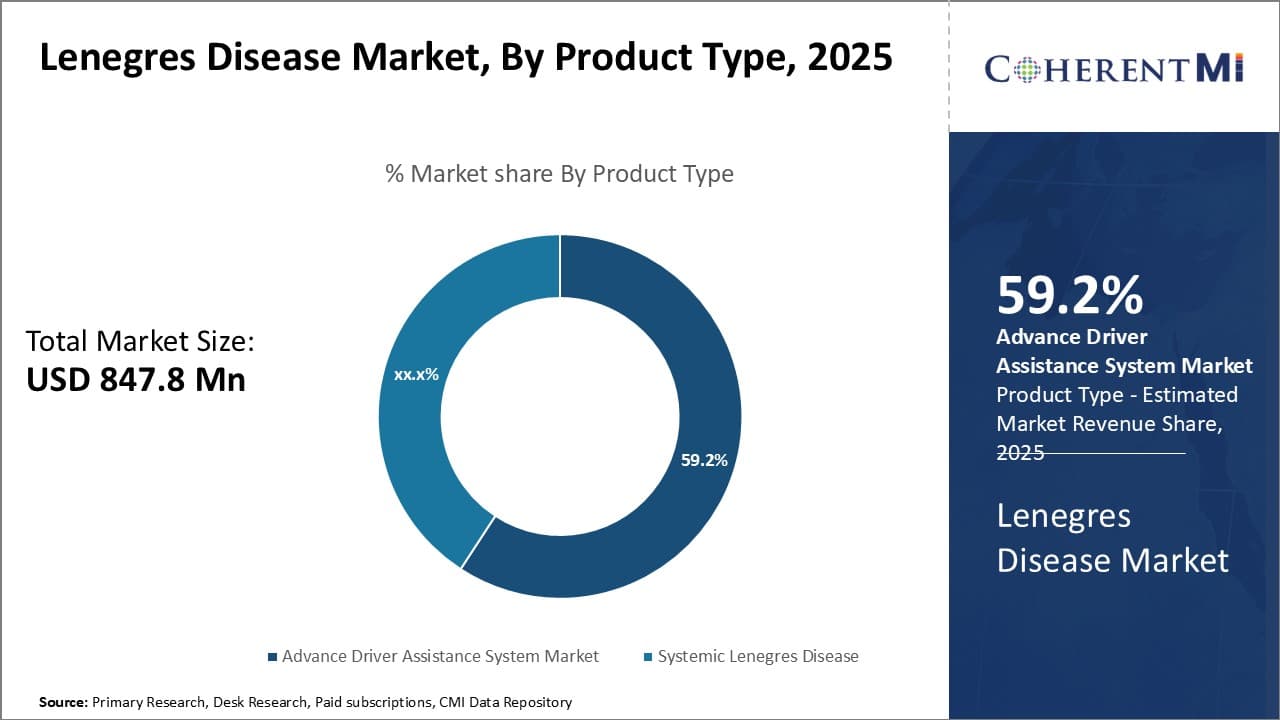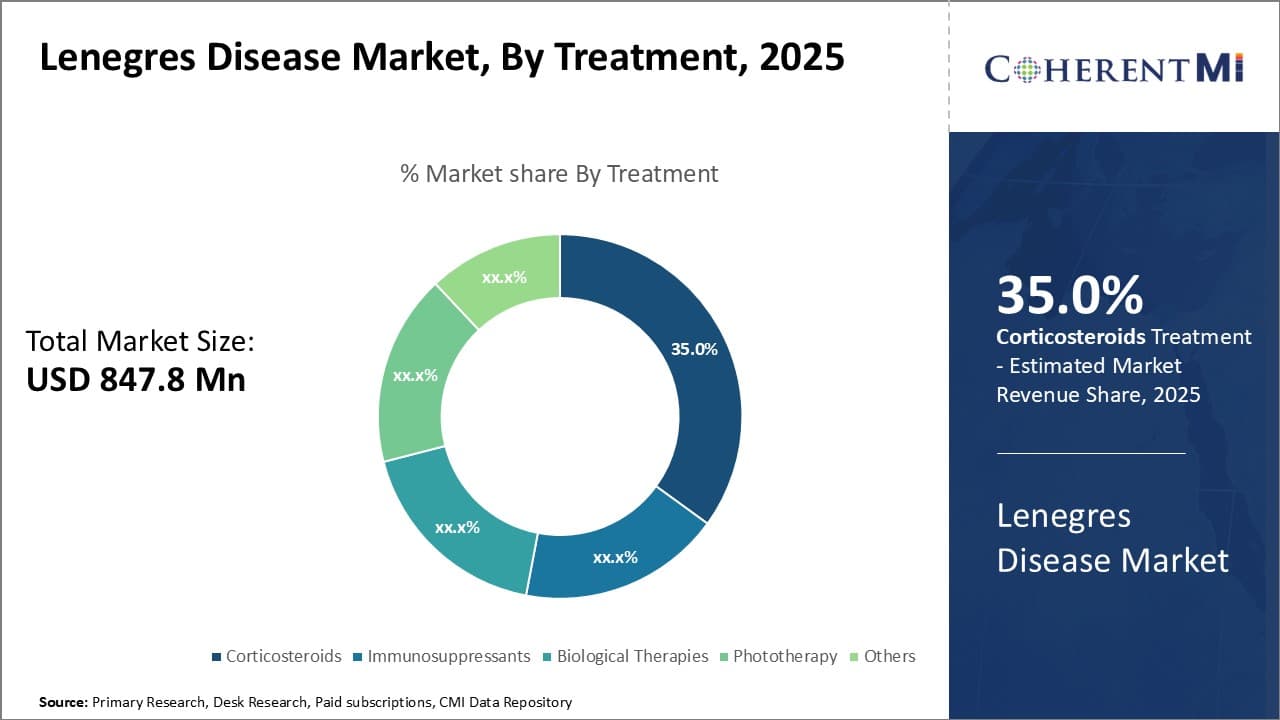

The Global Lenegres Disease Market is estimated to be valued at USD 847.8 Mn in 2025 and is expected to reach USD 1361.4 Mn by 2032, growing at a compound annual growth rate (CAGR) of 7.00% from 2025 to 2032. Lenegres disease is a rare genetic eye disorder that causes fluid build-up under the retina. The increasing prevalence of genetic eye disorders globally primarily drives the growth of this market.
The global Lenegres disease market is expected to witness steady growth over the forecast period. The market is anticipated to grow due to the rising genetic testing and increasing healthcare expenditure. In addition, the development of novel drug formulations and gene therapies for the treatment of Lenegres disease is expected to provide lucrative opportunities for market players. However, the shortage of treatment options and low diagnosis rates in developing nations are some of the factors expected to hinder the market growth.
Market Size in USD Mn
CAGR7.00%
| Study Period | 2025-2032 |
| Base Year of Estimation | 2024 |
| CAGR | 7.00% |
| Market Concentration | High |
| Major Players | GlaxoSmithKline (GSK), F. Hoffmann-La Roche AG, Pfizer Limited, Sanofi SA, Eli Lilly & Company and Among Others |
Market Driver - Rising awareness of Lenegre’s Disease among healthcare professionals and patients.
Awareness of Lenegre’s disease has increased significantly in the recent years among both healthcare professionals and patients. Various educational campaigns conducted by patient advocacy groups and non-profit organizations have played a crucial role in enhancing the understanding of this condition. Several renowned cardiologists and electrophysiologists have also taken initiative in educating other physicians about the symptoms, diagnosis and management of Lenegre’s disease. This has helped in early identification of more number of cases.
Previously, Lenegre’s disease was often misdiagnosed as some other cardiac condition due to lack of awareness. But now, even general physicians and cardiologists in primary care have fair knowledge about this disease. They are able to detect subtle symptoms and signs of Lenegre’s disease and refer high-risk patients to specialty care timely. Furthermore, with growing digitization in the healthcare industry, resources about Lenegre’s disease have become widely available online. Patients can easily access informative articles, videos and discussion forums to learn more about their condition. This has empowered them to participate actively in medical decisions.
The patient communities on social media platforms have also played a significant role in raising awareness. Patients share their experiences and spread knowledge which reach out to a broad audience. Others who may have similar symptoms are now more informed to discuss the possibility of Lenegre’s disease with their doctors. All these efforts towards creating awareness have increased the rate of accurate diagnosis and prevented delays in treatment initiation. With more patients being diagnosed, the need for advanced diagnostic modalities and management options continues to rise.
Incremental Healthcare Spending and the Growing Patient Pool
The rising healthcare expenditure on cardiology indicates greater financial allocation for treating cardiac conditions including Lenegre’s disease. Governments across different countries have increased their healthcare budgets recognizing the growing burden of cardiovascular illnesses. This has provided impetus to research into novel diagnostic tools, drugs and treatment protocols. More funding opportunities are being created to encourage pharmaceutical and device manufacturing companies to develop products specific to rare heart conditions like Lenegre’s disease.
At the same time, the total number of Lenegre’s disease patients is surging owing to the aging global population prone to develop the disease. Furthermore, the pandemic has highlighted the need to focus on cardiovascular health more vigorously. It is estimated that there will be over 50% rise in the geriatric population susceptible to Lenegre’s disease in the next couple of decades. More patients would require long-term clinical management, medications, implantable devices and procedures. This expanding patient population augment the demand for specialized services and drives the need for continued investments in research.
The rising investments and growing patient numbers work in tandem to fuel the market size. Governments are allocating higher public health expenditures while more patients require advanced care generating greater revenuepotential for the market. Both government and private sector are thus expected to pump in increased funding to develop new diagnostics, drugs and treatment solutions matching the emerging needs. This willingness to spend more on quality healthcare opens fruitful opportunities for companies in this industry.
 To learn more about this report, Download Free Sample Copy
To learn more about this report, Download Free Sample Copy
Market Challenge - High cost of treatment and limited availability of therapies.
One of the major challenges faced by the global Lenegre’s disease market is the high cost of treatment and limited availability of approved therapies. Lenegre’s disease is a rare genetic disorder with no approved disease-modifying treatments currently available. The few treatment options that exist mostly focus on managing symptoms and improving quality of life, but do not target the underlying causes or progression of the disease. This makes treatment extremely expensive in the long run for patients. Moreover, the rare nature of the disease means that pharmaceutical companies have little incentive to invest heavily in research and development of new treatments. This has resulted in very few therapies in the clinical pipeline for Lenegre’s disease. The limited competition in the market allows companies to charge very high prices for the few treatments that are available, placing an immense financial burden on patients, healthcare systems and governments. Overall, the high cost of existing symptomatic therapies combined with the lack of curative options poses a major challenge to growth of the global Lenegre’s disease market.
Market Opportunity: Development of Novel Therapies Targeting Lenegre’s Disease
One of the biggest opportunities in the global Lenegre’s disease market lies in the development of novel therapies that specifically target the underlying pathological mechanisms and progression of the disease. Recently, advancements in understanding the genetics and biological pathways involved in Lenegre’s disease have enabled researchers to identify several potential new therapeutic targets. A number of biotech and pharmaceutical companies have started exploring these targets for developing transformative disease-modifying treatments. Some of the modalities under research include gene therapies, RNA-based therapies and innovative protein therapies. If successful, these novel targeted therapies can potentially halt or reverse the effects of Lenegre’s disease rather than just managing symptoms. This will represent a major clinical advancement with benefits like reducing long-term healthcare costs and improving quality of life for patients. It also provides a large commercial opportunity for the first companies to develop and launch effective curative therapies for Lenegre’s disease. Overall, the market remains optimistic about the promising pipeline of novel targeted treatments for this condition.
Lenègre's disease is a rare non-ischemic cardiomyopathy characterized by fibrosis and scarring of the left ventricle. It typically progresses from early to advanced stages over many years.
In early stages, when ejection fraction is mildly reduced (40-50%), guidelines recommend starting with lifestyle modifications and beta-blockers like metoprolol succinate (Toprol-XL) or bisoprolol fumarate (Zebeta). If symptoms persist, calcium channel blockers such as amlodipine (Norvasc) may be added.
As the disease advances to moderate stages with EF 30-39%, prescribers often opt for angiotensin receptor blockers like losartan potassium (Cozaar) or valsartan (Diovan) in addition to previous treatments. If symptoms are uncontrolled, prescriptions may be upgraded to angiotensin converting enzyme inhibitors like lisinopril (Prinivil, Zestril) or enalapril maleate (Vasotec).
In late stages with severe systolic dysfunction EF <30%, aldosterone antagonists like spironolactone (Aldactone) or eplerenone (Inspra) are usually added as compensatory mechanisms begin to fail. Some may also consider implantable cardioverter-defibrillators if arrhythmia risk is high.
Age of onset and comorbidities additionally impact prescribers' preferences in Lenègre's disease management. Earlier diagnosis allows longer trials of guideline-directed medical therapy.
Lenegre's disease is a rare condition characterized by abnormalities in the conduction system of the heart. Treatment is based on the stage of the disease and symptoms.
In early stage disease without symptoms, the preferred option is conservative management with regular monitoring. If conduction abnormalities progress, drug therapy may be initiated. Calcium channel blockers such as verapamil or diltiazem are first-line medications to control heart rate and prevent progression.
For those with heart block, the treatment depends on the level of blockage. In first-degree or Mobitz I second-degree heart block, drug therapy is usually sufficient. But in Mobitz II or third-degree heart block, a pacemaker is needed for symptomatic relief and to prevent complications. Single-chamber ventricular pacemakers are typically implanted initially, but dual-chamber devices may be used for better hemodynamics.
As the disease advances further, patients may develop bundle branch block or intraventricular conduction delays in addition to heart block. At this stage, cardiac resynchronization therapy with a biventricular pacemaker has shown benefits in studies like REVERSE trial in improving symptoms and cardiac function.
For end-stage disease, heart transplantation may be considered for eligible patients. Immunosuppression is required post-transplant to prevent rejection. This offers the best chance of survival, but organ availability is limited and lifetime management of immunosuppression is needed.
Research and development: R&D is one of the most important strategies adopted by leading companies to stay ahead in the competitive Lenegre's disease market. For instance, Biotronik invested over $1 billion in R&D between 2010-2015 which helped them launch advanced pacemaker and implantable cardiac defibrillator devices for treatment of Lenegre's disease. Their REFORM CRT-P study introduced in 2013 evaluated the benefits of cardiac resynchronization therapy-pacemaker (CRT-P) and established its effectiveness for treating symptoms of Lenegre's disease.
Partnerships and collaborations: Players are partnering with clinical research organizations and healthcare providers to expand access to new treatment options and conduct clinical trials to gain regulatory approvals. For example, in 2018, Medtronic collaborated with Mayo Clinic on a Gene Therapy study for non-familial Wolff-Parkinson-White syndrome, a type of Lenegre's disease. This allowed them to test emerging therapies.
Geographic expansion: Leading companies have adopted strategies to expand into high-growth emerging markets like Asia Pacific and Latin America that offer huge patient pools and market potential. For instance, Boston Scientific opened new manufacturing facilities in India, China and Costa Rica between 2010-2015 to cater to the Asian and Latin American markets for Lenegre's disease treatment devices.
Mergers and acquisitions: Players pursue M&A activities to enhance their product portfolio and commercial presence. For example, Abbott acquired St. Jude Medical in 2017 for $25 billion which made it a global leader in the cardiovascular devices market including technologies for Lenegre's disease ablation.
 To learn more about this report, Download Free Sample Copy
By Disorder Type - Skin Involvement Drives Cutaneous Lenegres Segment
To learn more about this report, Download Free Sample Copy
By Disorder Type - Skin Involvement Drives Cutaneous Lenegres Segment
In terms of By Disorder Type, Cutaneous Lenegres Disease contributes the highest share of the market with 59.2% in 2025 owning to its direct effect on the skin. Cutaneous Lenegres primarily manifests as red rashes or papules on the skin that can cause burning, itching, and scaling. As the disease primarily impacts the appearance and comfort of the skin, patients are highly motivated to seek treatments to manage skin lesions and symptoms. The non-life threatening nature of cutaneous involvement also means patients have the time and resources to consistently adhere to long-term treatment regimens, driving recurring demand for drugs and physician visits in this segment. Skin symptoms also have a pronounced psychosocial impact, further incentivizing patients to actively manage their condition. The external visibility of skin signs also increases awareness and diagnosis rates within this segment. With the skin being the most accessible organ for physical examination, specialists are better able to monitor treatment responses objectively versus internal disease types. This enhances monitoring of therapy effectiveness and safety. As a result of these direct drivers, the cutaneous subtype accounts for the bulk of market value and growth within the overall Lenegres disorder landscape.
 To learn more about this report, Download Free Sample Copy
To learn more about this report, Download Free Sample Copy
By Treatment - Treatment Simplicity Boosts Corticosteroid Dominance
In terms of By Treatment, Corticosteroids contribute the highest share of the market with 35% in 2025 due to their favorable efficacy and safety profiles relative to alternatives. Corticosteroids work by suppressing the autoimmune response underlying Lenegres disease progression. As topical or low dose oral formulations, corticosteroids offer a well-established risk-benefit profile that allows them to be frontline treatment options. Their non-specific immunosuppressive action minimizes risks of drug interactions or selection of resistant pathogen strains compared to targeted biologics. Moreover, corticosteroids can be self-administered at home on an outpatient basis, improving adherence for chronic indications. This treatment simplicity is a key driver of corticosteroid uptake, bypassing the infrastructure investments and specialized personnel required for administering biologic infusions or phototherapy in medical facilities. Widespread physician familiarity with corticosteroids also boosts their early prescription. Given favorable safety, efficacy and convenience attributes relative to other Lenegres drugs, corticosteroids remain the standard first-line approach, maintaining largest market share within the treatment segment.
By End User - Access and Monitoring Drive Hospital Dominance
In terms of By End User, hospitals contribute the highest share of the market with 32% in 2025 due to their capacity for multi-disciplinary care. Hospitals offer specialized dermatology departments and rheumatology clinics equipped to handle complex Lenegres cases. They maintain diagnostic laboratories, imaging facilities and operating theaters required for invasive procedures like skin biopsies or joint surgeries involved in Lenegres. Inpatient care is also provided when indicated for acute flares or infections. Hospitals employ large specialist staff including dermatologists, rheumatologists and nurses with Lenegres expertise to optimize treatment decisions. This concentration of capabilities within a single access point improves convenience and compliance for patients requiring intensive induction therapies, monitoring or multi-specialty input to manage their disease. Hospitals also better support administration of infused biologics via dedicated outpatient infusion centers. Their role in residency training and research conducting further cements their expertise in managing Lenegres. Due to this comprehensive infrastructure and capability set, hospitals drive the highest diagnostic rates and treatment uptake within the Lenegres end user segment.
Lenegre's Disease is characterized by idiopathic fibrosis of the cardiac conduction system, leading to complete heart block. While the condition is often associated with aging, familial forms have been identified. The current treatment landscape is limited, and the market is poised for significant growth due to the increasing prevalence of the disease in the elderly population, coupled with advancements in diagnostic and therapeutic options. The market is expected to experience a surge in growth as new therapies are developed and launched, with companies actively investing in R&D to address unmet needs. The competitive landscape is moderately consolidated, with a few major players dominating the market.
The major players operating in the Global Lenegres Disease Market include Viatris Inc., Novartis AG, AstraZeneca, Bristol-Myers Squibb, Amgen Inc., Hikma Pharmaceuticals PLC, Dr. Reddy's Laboratories Ltd., ImmuPharma PLC, Merck & Co., Inc., Aurora Pharmaceuticals, UCB, Sandoz (a Novartis division), Bayer AG and Aurinia Pharmaceuticals.
Would you like to explore the option of buying individual sections of this report?
Ghanshyam Shrivastava - With over 20 years of experience in the management consulting and research, Ghanshyam Shrivastava serves as a Principal Consultant, bringing extensive expertise in biologics and biosimilars. His primary expertise lies in areas such as market entry and expansion strategy, competitive intelligence, and strategic transformation across diversified portfolio of various drugs used for different therapeutic category and APIs. He excels at identifying key challenges faced by clients and providing robust solutions to enhance their strategic decision-making capabilities. His comprehensive understanding of the market ensures valuable contributions to research reports and business decisions.
Ghanshyam is a sought-after speaker at industry conferences and contributes to various publications on pharma industry.
Lenegres Disease Market is By Product Type (Herbs, Spices, Essential Oils, Others (Plant Extracts, M...
Lenegres Disease Market
How big is the Lenegres Disease Market?
The Lenegres Disease Market is estimated to be valued at USD 847.8 in 2025 and is expected to reach USD 1361.4 Million by 2032.
What are the major factors driving the Global Lenegres Disease Market growth?
The rising awareness of lenegre’s disease among healthcare professionals and patients. and incremental healthcare spending and the growing patient pool. are the major factor driving the Global Lenegres Disease Market.
Which is the leading Disorder Type in the Global Lenegres Disease Market?
The leading Disorder Type segment is Cutaneous Lenegres Disease.
Which are the major players operating in the Global Lenegres Disease Market?
Viatris Inc., Novartis AG, AstraZeneca, Bristol-Myers Squibb, Amgen Inc., Hikma Pharmaceuticals PLC, Dr. Reddy's Laboratories Ltd., ImmuPharma PLC, Merck & Co., Inc., Aurora Pharmaceuticals, UCB, Sandoz (a Novartis division), Bayer AG, Aurinia Pharmaceuticals are the major players.
What will be the CAGR of the Global Lenegres Disease Market?
The CAGR of the Global Lenegres Disease Market is projected to be 7.00% from 2025-2032.